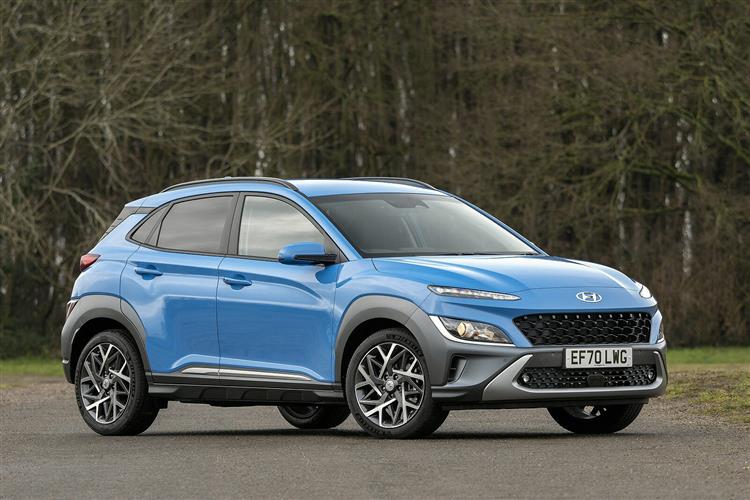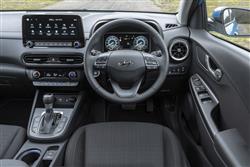KING KONE? (some text hidden) --NONE--
By Jonathan Crouch
Introductionword count: 82
'You drive it. You define it.' That was how Hyundai wanted us to view this car, their small Kona SUV. If you like cars of this kind, you're probably going to like this one because it ticks all the usual boxes in terms of style and fashionability. How will it fare on the used market in its standard forms though? Here, we're going to look at the facelifted 2021-2023-era versions of the mainstream combustion-engined first generation models and try and find out.
Modelsword count: 12
5dr SUV [1.0 T-GDi, 1.6 Hybrid, 2.0 T-GDi, Electric 39kWh, Electric 64kWh]
Historyword count: 316
Small crossovers are big business. Back in 2021, this one, the Hyundai Kona, had become the brand's second best selling model and by that point, nearly a quarter of a million Konas had found European owners since this car's original launch back in 2017. For the 2021 model year, it got a substantial mid-term update, creating the version we're going to look at here. The Kona started life competing with SUVs based directly on superminis - Renault's Clio-based Captur, Nissan's Micra-based Juke and so on. Even though it sat on a platform originally intended for models in the next segment up. But by 2020, Hyundai had a proper supermini-sired SUV - the i20-based Bayon - positioned to sit below this car as the entry-point to this Korean maker's crossover line-up. So the Kona could be pushed up-market a little, to take on more expensive small SUVs - and maybe also to offer an alternative to the Korean brand's i30 family hatch. A little more sophistication was required for this car to be able to meet this remit. A huge proportion of i30s of this period were being sold with sporty spec, so this enhanced Kona got that too - a more dynamic 'N Line' level of trim and a full-fat Kona N high performance variant joined the range. A line-up which by now was all-petrol powered and all fully electric; even the entry-level versions offered a 48V mild hybrid 1.0-litre powerplant, which sat below a full dosing of the Korean manufacturer's battery technology. Customers chose between a full-Hybrid 1.6-litre combustion version. Or a full-Electric derivative (also substantially updated), with a driving range of up to 300 miles. If you knew this car in its original guise, with this facelift version you'll notice a general smartening up of the styling. And a much enhanced level of media tech inside. A new MK2 Kona design arrived in mid-2023.
What You Getword count: 394
A car of this kind has to evoke a reaction from you: that's part of the point of it. And the Kona has always done that, with its muscular toning, sensuous surfaces and high-contrast fender cladding. With the initial version though, all of this was a bit, well, in-your-face - a touch unsubtle. With this updated model though, the look was far more cohesive, gym toned and confident. This is how you do a facelift. The front of cabin experience became more sophisticated in this form. Through the steering wheel, you view a 10.25-inch screen with virtual dials, while providing you avoid entry-level trim, there's a vastly bigger central infotainment screen than with the original model - also 10.25-inches - full of features Kona folk had never had access to before. Hyundai tried to emphasise the dashboard's horizontal layout by separating the lower console area from the instrument panel. And a range of little trimming touches attempted to improve the cabin ambiance. But there was still a lot of black plastic and little of the extrovert vibe that characterised the bodywork. Some would hope for a slightly more commanding driving position too, in a car characterising itself as an SUV. On the plus side, the seats are reasonably comfortable and there's plenty of storage space. It's also easy to find a comfortable driving position, thanks to lots of wheel and seat adjustment. And in the rear? Well it's in this part of the car that you're likely to be most keenly reminded that you've bought an SUV based on a supermini-sized chassis, rather than that of a family hatchback. As it turns out, it's not too bad in the back for the carriage of two folk, providing they're not especially lanky of leg. If they are, then compromises will be need to made by the front seat occupants in order to be able to accommodate them. Let's finish with a few words on boot space. The tailgate is light to lift and reveals a 374-litre luggage area in the mild hybrid model; it's the same with a full-Hybrid Kona, but the figure falls to 332-litres with the Kona Electric. Push forward the 60/40 split-folding rear seat and you'll reveal a relatively flat loading floor with (in the mild hybrid variant) as much as 1,143-litres of total fresh air if you load to the roof.
To see the full road test text contact us on 0330 0020 227
Pictures (high res disabled)

.jpg)
|
.jpg)
|
.jpg)
| |||
.jpg)
|
.jpg)
|
.jpg)
| |||
.jpg)
|
.jpg)
|

|
Scoring (subset of scores)
Category: Crossover or SUV 4x4s
| Performance | |
| Handling | |
| Comfort | |
| Space | |
| Styling, Build, Value, Equipment, Depreciation, Handling, Insurance and Total scores are available with our full data feed. | |



